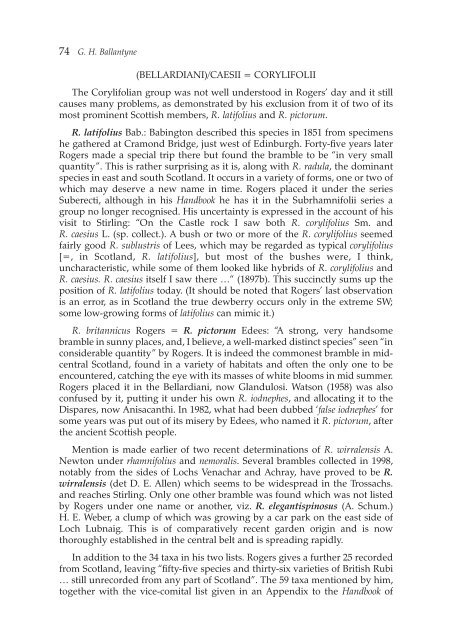the Forth Naturalist Historian - Forth Naturalist and Historian ...
the Forth Naturalist Historian - Forth Naturalist and Historian ...
the Forth Naturalist Historian - Forth Naturalist and Historian ...
You also want an ePaper? Increase the reach of your titles
YUMPU automatically turns print PDFs into web optimized ePapers that Google loves.
74 G. H. Ballantyne<br />
(BELLARDIANI)/CAESII = CORYLIFOLII<br />
The Corylifolian group was not well understood in Rogers’ day <strong>and</strong> it still<br />
causes many problems, as demonstrated by his exclusion from it of two of its<br />
most prominent Scottish members, R. latifolius <strong>and</strong> R. pictorum.<br />
R. latifolius Bab.: Babington described this species in 1851 from specimens<br />
he ga<strong>the</strong>red at Cramond Bridge, just west of Edinburgh. Forty-five years later<br />
Rogers made a special trip <strong>the</strong>re but found <strong>the</strong> bramble to be “in very small<br />
quantity”. This is ra<strong>the</strong>r surprising as it is, along with R. radula, <strong>the</strong> dominant<br />
species in east <strong>and</strong> south Scotl<strong>and</strong>. It occurs in a variety of forms, one or two of<br />
which may deserve a new name in time. Rogers placed it under <strong>the</strong> series<br />
Suberecti, although in his H<strong>and</strong>book he has it in <strong>the</strong> Subrhamnifolii series a<br />
group no longer recognised. His uncertainty is expressed in <strong>the</strong> account of his<br />
visit to Stirling: “On <strong>the</strong> Castle rock I saw both R. corylifolius Sm. <strong>and</strong><br />
R. caesius L. (sp. collect.). A bush or two or more of <strong>the</strong> R. corylifolius seemed<br />
fairly good R. sublustris of Lees, which may be regarded as typical corylifolius<br />
[=, in Scotl<strong>and</strong>, R. latifolius], but most of <strong>the</strong> bushes were, I think,<br />
uncharacteristic, while some of <strong>the</strong>m looked like hybrids of R. corylifolius <strong>and</strong><br />
R. caesius. R. caesius itself I saw <strong>the</strong>re …“ (1897b). This succinctly sums up <strong>the</strong><br />
position of R. latifolius today. (It should be noted that Rogers’ last observation<br />
is an error, as in Scotl<strong>and</strong> <strong>the</strong> true dewberry occurs only in <strong>the</strong> extreme SW;<br />
some low-growing forms of latifolius can mimic it.)<br />
R. britannicus Rogers = R. pictorum Edees: “A strong, very h<strong>and</strong>some<br />
bramble in sunny places, <strong>and</strong>, I believe, a well-marked distinct species” seen “in<br />
considerable quantity” by Rogers. It is indeed <strong>the</strong> commonest bramble in midcentral<br />
Scotl<strong>and</strong>, found in a variety of habitats <strong>and</strong> often <strong>the</strong> only one to be<br />
encountered, catching <strong>the</strong> eye with its masses of white blooms in mid summer.<br />
Rogers placed it in <strong>the</strong> Bellardiani, now Gl<strong>and</strong>ulosi. Watson (1958) was also<br />
confused by it, putting it under his own R. iodnephes, <strong>and</strong> allocating it to <strong>the</strong><br />
Dispares, now Anisacanthi. In 1982, what had been dubbed ‘false iodnephes’ for<br />
some years was put out of its misery by Edees, who named it R. pictorum, after<br />
<strong>the</strong> ancient Scottish people.<br />
Mention is made earlier of two recent determinations of R. wirralensis A.<br />
Newton under rhamnifolius <strong>and</strong> nemoralis. Several brambles collected in 1998,<br />
notably from <strong>the</strong> sides of Lochs Venachar <strong>and</strong> Achray, have proved to be R.<br />
wirralensis (det D. E. Allen) which seems to be widespread in <strong>the</strong> Trossachs.<br />
<strong>and</strong> reaches Stirling. Only one o<strong>the</strong>r bramble was found which was not listed<br />
by Rogers under one name or ano<strong>the</strong>r, viz. R. elegantispinosus (A. Schum.)<br />
H. E. Weber, a clump of which was growing by a car park on <strong>the</strong> east side of<br />
Loch Lubnaig. This is of comparatively recent garden origin <strong>and</strong> is now<br />
thoroughly established in <strong>the</strong> central belt <strong>and</strong> is spreading rapidly.<br />
In addition to <strong>the</strong> 34 taxa in his two lists. Rogers gives a fur<strong>the</strong>r 25 recorded<br />
from Scotl<strong>and</strong>, leaving “fifty-five species <strong>and</strong> thirty-six varieties of British Rubi<br />
… still unrecorded from any part of Scotl<strong>and</strong>”. The 59 taxa mentioned by him,<br />
toge<strong>the</strong>r with <strong>the</strong> vice-comital list given in an Appendix to <strong>the</strong> H<strong>and</strong>book of



